



I suspect many you are like me: there is something dramatically wrong with your body and it has been that way for quite a while. You surf the ups and downs of your symptoms and occasionally wonder, “What does this symptomatic change mean?”
If you are like me, you have learned that most medical doctors are not much help, and even if they are interested in helping you, they are too harried to spend any extra time investigating your odd collection of symptoms. So eventually we find that our best resources default to learning from other patients and keeping up on the latest research that might be applicable to providing some relief, if not a cure.
About three months ago I was doing my usual hunting and pecking around the Internet in a search to better understand the interplay of two long-standing symptoms of mine that had driven me to despair: myofascial pain/trigger points and allodynia. I found a patients’ website for CRPS (Complex Regional Pain Syndrome) where the author strongly suggested that allodynia sufferers try sitting in a neutral temperature therapy pool. “Try it; it will reduce your allodynia”, she wrote. (I wish I could find that website again so I could attribute and thank her, but, alas, no luck.)
So I went and sat in a neutral temperature therapy pool for 10 minutes (start low, go slow) and there was a tiny shift in my allodynia and myofascial pain symptoms that faded away after a day or so. That was 4 months ago. I have continued twice a week since then and I am up to 30-35 minutes a soak resulting in a small and somewhat temporary, but noticeable, lessening of allodynia and myofascial pain.
In the 20 years of having these miserable symptoms, I have never had any success with anything I have tried, so I was curious about what was happening. I asked numerous medical practitioners if they knew why sitting on my butt in neutral temperature water would help produce this shift in my symptoms.
None of them knew — I will refrain from my desire to make some cynical comments here — so I went out and wrangled myself up a huge digital stack of research papers on human physiology and water immersion.
The Science
Health practitioners usually recommend people with chronic illnesses use a “neutral temperature” therapy pool because it will induce the least stress.
The temperature of a neutral temperature pool is near the human body’s internal temperature, which is a good temperature for people who will largely be inactive within the pool. The Aquatic Physical Therapy Section of the American Physical Therapy Association has a general recommendation of 92 to 96°F for the inactive patients and 88 to 92°for arthritic patients.
The pool I go to is 92°, which is my normal skin temperature. Some days, when I get in the water, it feels a little cool and some days it feels a little warm. This pool is the only choice I have, and I feel lucky to have access to this inexpensive community therapy pool.
The hydrostatic pressure of water in a pool will compress the immersed part of your body (similar to how compression stockings compress your legs). The water will also push your body upward. Interestingly for people with ME/CFS the increased hydrostatic pressure also results in a pretty dramatic rise in the central blood volume (in the thorax region). Blood volume and stroke volume in the human heart also dramatically increase.
How much of an increase depends on how deep you are immersed, whether you are sitting, standing, or doing a back float, the water temperature, and your activity level. The increased blood volume and the upward displacement of the abdomen contents and diaphragm in the thorax cavity makes it much harder for your lungs to work and for you to breathe. That causes your heart to compensate by working harder. Come to think of it, this sounds similar to what happens when we exercise!
When you are in the pool, your heart is pumping harder and expands with more blood. That causes your blood to circulate faster with increased volume towards your peripheral limbs and head.
About a quarter of your heart’s output goes through your kidneys, which results in more changes. When the cardiopulmonary stretch baroreceptors detect increased blood volume in the thorax, they decrease your kidneys’ sympathetic activity.
This results in increased urine excretion (you want to pee much faster.) The sources I used quoted a sevenfold increase in urine excretion. I come from a family of almost fishlike siblings. We really liked the water. Keeping with my curious nature, I used to wonder why I would have to stop swimming to take a pee when I never was drinking any water. Now I know
Two other renal related physiological changes occur with water immersion: increased natriuresis (sodium excretion in the urine) and paturesiss (potassium excretion). These two processes lower the amount of sodium and potassium in your blood. This is not a good thing if you have POTS (Postural Orthostatic Tachycardia Syndrome) and are taking blood volume enhancers that have already lowered sodium or potassium levels.
It does explain, however, why, after coming home from a 20 or 30-minute soak in the therapy pool, I’d often feel exhausted and fall asleep for a couple hours. Nowadays I take a quart of water with some potassium and sodium salts and other electrolytes with me and drink it after the soak.
About Me
At this point, let us take a break and let me give you a little personal information. I fall into the patient subgroup of ME/CFS with co-morbid fibromyalgia, POTS, and CRPS/RSD-like neuropathic pain (allodynia). I have been walking around feeling like I have blocks of ice on my feet for years.
Some time ago, before I knew about POTS, vasodilation, or vasoconstriction, I was grousing to myself about my cold feet and ankles. I looked on my coffee table and saw a thermal infrared gun I was using to detect insulation leaks in my house. It’s a cool little device: you just point it at something and it tells you the surface temperature of the object.
So I took off my socks and pointed the thing at my feet and then at my thigh. My thigh was 92°F and my feet were 72°F. I’d noticed when I first entered the therapy pool that my feet felt cold, while the rest of my body did not feel much thermal change. The rest of the day, though, I would not have much problem with cold ankles.
So I took my trusty thermal infrared gun to the therapy pool and zapped my feet before entering and at my feet after a half an hour in the pool. My feet were 72°F before entering and 92°F after exiting. Why?
Peripheral vasodilation and autonomic balancing
Now comes some good news about water immersion. I thought that the increased cardiac stroke volume and output should result in an increase in blood pressure. Instead, your body detects that increased cardiac output and causes peripheral vasodilation (areas peripheral to the thorax cavity have vasodilation increase) to accommodate the increased cardiac output.
The means more blood flows to your tissues, and, in my case,no more cold feet. Water immersion also affects the autonomic nervous system. The autonomic nervous system is a control mechanism for the systems in our body that we don’t consciously control: the cardiovascular system, the gut, thermoregulation, etc.
Heart rate variability analyses of water immersion have associated it with decreased sympathetic influence and a “balancing” of the autonomic nervous system.
It appears that thermo neutral water immersion pushes the autonomic system towards being back in balance. This is a very good thing for the many people with chronic and/or autoimmune diseases that feature sympathetic arousal, such as fibromyalgia, ME/CFS, POTS, CRPS, and multiple sclerosis.
Reduced myofascial pain and allodynia
I still wondered why thermoneutral water immersion seems to temporarily reduce my myofascial pain symptoms of excruciatingly painful trigger points, and taut, ropey muscles (ugh!). I could find nothing mentioning muscles in my research until I came across a paper by Petrofsky, et.al. on hydrotherapy and the cardiovascular system and muscle relaxation.
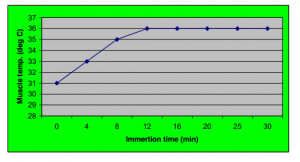
Credit: Petrofsky, et.al. “The Influence of Warm Water Hydrotherapy on the Cardiovascular System and Muscle Relaxation”
In this study they took 10 healthy 20 to 30-year-old students and immersed them in 96.8°F (37°centigrade) water for 30 minutes. These brave (or is it naïve?) students endured a slew of probes, insertions and adhesive patches to measure the myriad of functions including heart rate, blood volume, blood flow to the muscles and skin, and muscle temperature and stiffness.
The results were enlightening. They found that the limb muscle temperature increased from 31°C at the beginning of water immersion to 36°C after 12 minutes and stayed at that temperature for the rest of the immersion period. Both muscle and skin blood flow increased, with muscle blood flow increasing faster and more dramatically. Within 20 minutes of immersion the blood flow in the muscle increased 300% (!) and then stayed at that level for the rest of the immersion period. The skin blood flow continued to rise throughout the 30 minute immersion, finally leveling off at a 200% increase.
They also found significant relaxation in the muscles and reduction in the activity of associated alpha motor neurons. These authors speculated that a 6°C increase in muscle temperature would conservatively result in doubling or tripling the muscle metabolism.
They also found that the heart stroke volume, heart rate, and cardiac output was significantly higher, but no significant difference in blood pressure was seen from the beginning to the end of immersion. This implied vasodilation was taking place in the rest of the body.
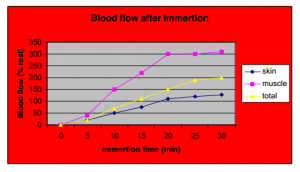
Credit: Petrofsky, et.al. “The Influence of Warm Water Hydrotherapy on the Cardiovascular System and Muscle Relaxation”
Interestingly, they also tested the subjects while exercising lightly in the immersion pool, and then outside of the pool on a stationary bicycle. Skin and muscle blood flow and muscle relaxation were significantly greater in the subjects when they were immersed in the thermoneutral water and not exercising.
In fact, stationary bicycling without immersion had no significant effect at all on skin blood flow at all. The authors concluded that if muscle relaxation is the goal of water immersion therapy, then exercise in the pool should not be attempted.
So what does all this mean? My guess is that passive immersion in thermoneutral water results in peripheral vasodilation and increased blood flow everywhere, including the muscles, which in some ways mimics exercise — but without the added oxidative stress, lactic acid, and other detrimental effects that cause the delayed muscle pain and malaise familiar to many of us patients.
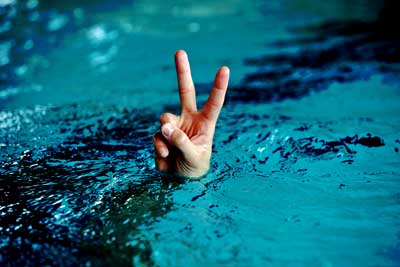
However it works it helped; neutral temperature pool immersion was the first thing to help Tim’s allodynia for decades
What about allodynia? One of my previous posts on Cort’s website indicated that McGill University (a leading pain research institution) researchers found that microcirculation issues resulting in ischemia contributed to allodynia.
Perhaps, the increase in blood flow to the peripheral muscles and skin while in the immersion pool results in reduced ischemia and allodynia. It’s also possible that, as some authors speculate, when your body is immersed in water the nociceptors that sense touch and temperature are bombarded with signals and block out the allodynia. My bet is on the increased blood flow.
Conclusion
Knowing the science of thermoneutral water immersion will keep me trudging down to my community center pool, paying a few dollars, and sitting in water the same temperature as my skin. While I’m there I’ll contemplate how after almost 20 years of poking, prodding, tilting, and jolting (ever have a nerve conduction test? no fun) in addition to enduring countless pharmaceutical side effects without any positive symptomatic effects while spending a significant amount of money within a broken healthcare system, something so simple as sitting in warm water has backed me off of the edge of despair.
The coolest part about it? It is pleasant and enjoyable.
Addendum: If you’re going to try thermoneutral water immersion, I highly recommend you follow the old slogan of “start low and go slow” and rehydrate with electrolytic fluids.
I have experienced some dramatically negative effects when I overdid activities or duration time in the pool, or did not rehydrate.
Healthcare practitioners kept encouraging me to do more active stretching and more muscular exertion, but every time I took their advice I had some dramatic crashes afterwards. Go slow, and pay attention to your body’s response. Everybody’s body is different and you know your body better than anyone else. For my body, less is more.
- Check out more of Tims Health Rising Blogs here
Additional Reading: THE INFLUENCE OF WARM HYDROTHERAPY ON THE CARDIOVASCULAR SYSTEM AND MUSCLE RELAXATION. Jerrold Petrofsky, Ph.D., JD Jaime Baxter, BS Jaime Bomgaars, BS Carrie Burgert, BS Sara Jacobs, BS Danielle Lyden, BS Everett B. Lohman III, DPTSc, OSC.
Hydrotherapy for the Treatment of Pain in People with Multiple Sclerosis: A Randomized Controlled Trial. Adelaida Marıa Castro-Sanchez, Guillermo A. Mataran-Penarrocha, et. al., Evidence-Based Complementary and Alternative Medicine, Volume 2012, Article ID 473963.
Rehabilitation Medicine Improvement in Anxiety and Pain After Whole Body Whirlpool Hydrotherapy Among Patients With Myofascial Pain Syndrome. Ann Rehabil Med 2013;37. Sang Hee Im, MD, Eun Young Han.
Biophysiologic Effects of Warm Water Immersion. Bruce E. Becker, Kasee Hildenbrand, Rebekah K. Whitcomb, and James P. Sanders. International Journal of Aquatic Research and Education, 2009, 24-37 ©2009 Human Kinetics, Inc.
Age-Dependent Autonomic Changes Following Immersion in Cool, Neutral, and Warm Water Temperatures. Kasee Hildenbrand, Bruce E. Becker, Rebekah Whitcomb, and James P. Sanders. International Journal of Aquatic Research and Education, 2010, 127-146 ©2010 Human Kinetics, Inc. Al Haddad, H., et al.,
Effect of cold or thermoneutral water immersion on post-exercise heart rate recovery and heart rate variability indices, Auton. Neurosci. (2010), doi:10.1016/j.autneu.2010.03.017


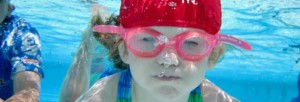
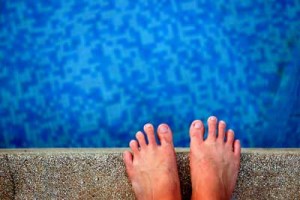
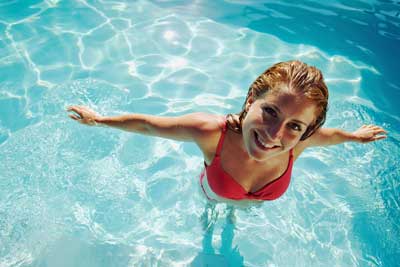
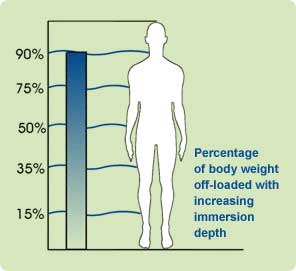
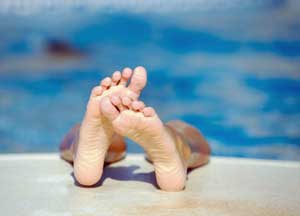

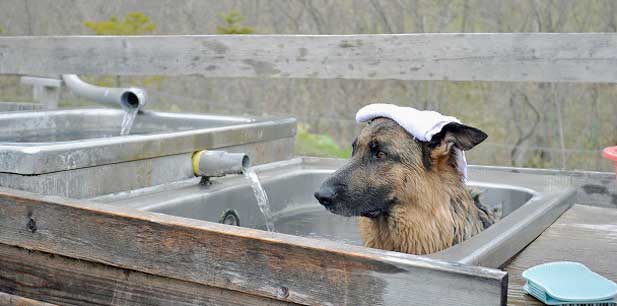




I’m going to try this as soon as I can find a swimsuit!
this is one of the best articles I have read. After 28 years of suffering with ME/CFIDS, POTS,etc we moved from NY to NC. Bought a house with a pool which was totally foreign to me coming from NY with winters lasting 10 months out of the year. Took me awhile to go in, can’t swim and not comfortable in the water but eventually I started going in and just standing there or sitting working my way up to splashing around. The shock of the water on my cold skin took me back a bit and it took me longer to ease in then I spent in the pool but I felt good getting out then I had to have surgery so I missed going in for a year then I had a few heart attacks and missed even more so after reading this I am hoping to start slowly again. I just dipped my feet in the pool and it is like bath water so baby steps is my way of thinking. Thank you for posting this!
You are welcome. If you could raise that water temperature up towards your skin or body temperature, it might ease your way into the pool. I certainly find it very hard to spend time in a cold water pool, without exercising to compensate for the heat loss.
If your feet are colder than the pool then when u enter heat will transfer to your feet when you enter thereby activating your heat receptors and u will feel warmer on entry not colder
Thank you for this. My brother and sister-in-law sent me $ to buy a pass for the local community pools, which include a warm water therapy pool. I’m eager to try it, but haven’t had the energy to go across town to the pool yet! Now I have more motivation. Like the author I grew up in the water, and was a competitive swimmer from age 10-18. It’s hard for me to be in a pool and not exercise! :-). I haven’t been able to tolerate getting in a normal temperature pool for some years (unless it’s over 87 degrees it feels bad to me). I appreciate your details of the physiology involved. Sounds reasonable. I didn’t know about the increased electrolyte loss in water immersion; I will remember that.
Many thanks, TimV, and many thanks for the citations. I’ve suffered from the identical pain symptoms for 25 years, especially the feet, and getting intolerable. Oddly, I never considered going to a pool (not many local options) but rather tried to scald my feet in a tub to stress the nerves to destimulate/satiate them, probably an idea with no scientific foundation and it doesn’t work fantastically. Pretty weird, a local feed store is having a sale on a big rubber cattle watering trough and, if I can jam it into my car, before this essay appeared I had already decided to buy it and try some water soaking experiments. Now I have a good schema to follow. A “redneck hot tub”…can’t lose much. I’d walk naked through the Smithsonian if it would diminish pain.
Steve,
I love it! I used to spend a lot of time in the rural western United States and I’m done plenty of redneck hot tubs.
Everything I have read says that the deeper you immerse your body, the better effect you get from the water immersion.
You’re funny. What we need is a lot more humour! It’s good to laugh!! If you’re planning to walk you through this Smithsonian please let me know when. Giggle giggle since this is being written by the authors in light grey instead of dark black I am assuming there to be something wrong I will not be published. I hope I am wrong.
Wow interesting. So far any warm water or being in the sun in water crashes my bp. Interestingly Fir Infrared Sauna does not. I am pain free after 30 minutes at 120 degrees, it lasts most of the day. I do it every morning..
I can lie or sit in the sun but walking in the sun is crash time. Funny how the sauna does not bother me. I drink plenty of water and an electrolyte drinks..
I cannot sit in a bath of warm water, always a quick shower. Go figure!
Hello. I’m wondering what you meant by pain-free. What kind of condition did you have. I’m trying to get pain free from my tactile allodynia which is driving me nuts. I literally stay in bed all day because I can’t stand moving around as everything that touches my skin feels like a thousand needles poking into it even though softest of cloth and sheets. I desperately need some answers. I’ll certainly try what the author suggests which is a therapy pool which I’ve never heard of. Skin temperature water is a pleasure whereas anything under that I abhor. Thank you so much author for writing all the stuff and being so detailed in your answers
Thank you, this is very fascinating and really explains so much about ME/CFS. I agree with the author the only way to feel better and find ways to survive is information from sources other than traditional health care. For me Dr. Wahl’s diet has made a huge difference, along with using herbs and spices for pain. I have been able to use pacing with huge success. The more we learn about ME/CFS the more we figure out how to live with it, which after decades of government research blocking is all I expect to happen in my lifetime.
Hello. Can you tell you me what you mean by the words Walsh (sorry my phone wont allow his name to be printed properly!!)
Anyway I don’t know this fellow and would like to know what he has to say maybe you could summarize for me? And I couldn’t agree with you more. People who have skin problems should have easily run away from their GPS. Because they have not a clue what to do with you. They only want thing that they want to do is to show you the door they can’t wait for you to get out of their office. It’s not that they’re being unsympathetic but they just don’t have the answers. They always saying you got to have it to know it fits here. If any anyone could tell me what doctor they would choose out of all the many doctors out there as far as their profession goes that is ,if they think they may have had some help from them please contact me. I’ve had this tactile allodynia for several months now. I used to get it once in a while but this is going on for months. I’ve never heard of these therapy pools but I will try them as soon as I find one. It sounds absolutely wonderful. Only thing is I don’t think I ever want to get out of it. I was wondering if those who used to stare people does the effect last long or does it stop the minute you get out of the pool. Thank you very much
My foot pain started as plantar fasciitis after jogging on pavement, but never went away despite all the interventions (even trying shockwave therapy, intermuscular stimulation, injections, anti-inflam cream, hot/cold contrast bathing, stretching, exercises, night braces, orthotics, etc). I don’t know why I’d develop neuropathy but it’s definitely not plantar fasciitis anymore. My toes usually feel like ice unless I heat them with a heating pad. I normally cannot walk or stand more than 30 seconds without developing pain on the bottom of my feet lasting for hours, so 95% of the time I am in a wheelchair.
On a whim, I tried wading in the ocean on a sandy beach with the idea that I would strengthen what I supposed to be atrophied foot muscles. I knew I would be in pain for hours after the 10 min walk, but it turns out the cold water seemed to give me a free pass. I can’t imagine the kind of pain I’d have after 10 min of walking on the ground but after the water wade, my feet did not develop the expected pain.
Another occasion 2 non-CFS people came wading with me, and they danced around saying it was so cold, and quickly hopped out, so I know that my feet aren’t transmitting the cold signal to me. I have no idea what’s going on, and it’s not a cure, but it’s a nice surprise to be able to walk a bit when I’m at the shore in the summer.
JJ,
Yes, confusing. I encourage you to talk to everyone you can think of about what they would think is going on that’s causing the pain difference cold water versus Land. In the world of pain they differentiate between thermal allodynia and mechanical allodynia. My allodynia his mechanical, possibly yours is thermal?
Thank you for taking the time to write this article!
I personally lose track of very important information and it benefits me to hear about methods that I thought would be a benefit and then lost track of what I was going to DO!
On another subject, I find it refreshing that among people with ME/CFS, Fibro, MS and all the other neurological illnesses that bring us to CJ’s site, that there are very few trolls and individuals afflicted with Hypergoogleism (the need to impress the lower caste with their vast knowledge of a subject). It shows how much we have learned to recognize how little we really know.
Thank you again for the article. You would have made an excellent scientist.
Will laying in a bathtub matter, or is it important to be upright while submerged in the water?
JJ,
I don’t know, but give it a try. I suspect it will have similar effects. The amount of benefits from body temperature water immersion is dependent upon the depths of your body that is immersed, according to the literature. But if you have cold feet and legs, I bet the warm bath water would work fine. Try it and go slow and Start low…. Good luck.
I expect that’s why I take so many hot baths! It is usually the 1st thing I resort to when I’m real stressed and feeling anxious. Sometimes I use epsom salts. I know that I get to sleep better after a warm bath. I often have cold feet/ankles, too, which makes it hard to get to sleep.
Great article Timv and kudos for going after the why behind why it may be working so systematically (the infrared gun was genius).
Ischemia does sound likely. I’m currently debating whether or not to try a very low dose of a beta blocker for heat intolerance but do have concerns that Raynauds is one of the possible side effects due to vasoconstriction.
I’m pretty sure though that individual successes like this must be telling us something about the underlying problem and should be valuable clues for researchers. If you don’t mind me asking did you find any other beneficial effects?
PS @Steve – “redneck hot tub”. Love it!
What a novel use of the infrared gun – yes, genius 🙂
Marco,
Yeah guys seem to love the infrared heat gun. I waltzed into my doctors office and pulled out that infrared gun to show them and demonstrate the temperature difference between my feet and my thighs. He looked at that gun and said, “cool”, and then spent the next five or 10 minutes pointing at everything in his office and measuring the temperature. My only thought was, “I’m paying $300 an hour for this guy to play with this infrared gun.”
As far as other beneficial effects, need some time to think about that and then respond to you.
I guess to do the redneck hot tub, might be useful to have a infrared gun. Even cooler mine comes with a holster!
🙂
I needed a good laugh ….
They put me on a beta blocker a couple yrs ago for moderately elevated blood pressure, and it gave me weekly BiPolar II mood swings! Took me months to figure out. I may have had BiPolar anyhow, but it definitely aggravated it. The symptoms came back with the seasonal depression in the fall and winter, but the swings weren’t as frequent. While on the beta-blocker I was having several days of severe depression alternating with several “high” days in which I seemed relatively “normal” but during which I talk incessantly and blurt out everything and anything~very embarrassing! Sometimes I’m jealous of those with BiPolar I as they, at least, get energy bursts, whilst I am totally exhausted most of the time…
Very interesting. Cumbria hospital was offering exercise therapy in an extra warm pool in the infirmary for folk with fibromyalgia but really interesting to separate the effect of sitting in a pool at the right temperature from exercising in a pool. Also interesting the idea of taking temperature in different regions of the body which suggests the possibility of a simple objective physical test to determine whether something is wrong. Perhaps we should all buy spas.
Thank you for this interesting posting.
For over 40 years I have taken a warm shower every morning, due to nerve pain in my face and head. I have always said and still comment today that this is my morning therapy to make me feel better and get me going for the day. I have ME and neuropathy with no clear pathway to a set of nerves.
I really encourage you to try to be neutral temperature pool immersion. I’d be very interested to see what your responses after you build up to 20 minutes or more of immersion time.
I am so happy to see this article. I have been doing gentle aquatic exercise (think really, really gentle range of motion stuff) in a warm water pool for years and it has helped my CFS symptoms a great deal. We combine Feldenkrais, yoga, tai chi, Arthritis Foundation moves into our routine and it is amazing. It is a totally unique class taught by an innovative and caring instructor and I wish everyone had access to it. You will never improve if you don’t keep trying nee things to fin what works for you, and I’d encourage anyone to give it a go if they have access to a pool that is 86-94 degrees.
Linda,
It is good to hear your comment. Every time I had problems and increased pain from the pool I was from doing something more than gentle range of motions that you describe. If I would’ve known you were had contact with you I would’ve save myself a lot of pain and misery. If I exercise too much or stretch too hard I have post immersion pain and Crashes. Of course every healthcare practitioner I run into keeps pushing me to try to exercise more. I’ve learned to just ignore them and go slow and low and keep in the near body temperature water.
PS: I also have all the symptoms of a Raynaud type illness. i.e. cold head, hands, feet and also symptoms similar to POTS and vascular problems.
I suffered a fractured nose from playing with a the pet dog, when in my twenties, yet living abroad shortly afterwards in a hot climate seemed to have cured the sore scalp. However, I have always had the cold periphery problems, even while abroad.
ME did not develop until 2006, but I’m sure it must have been present for many years without me realising the symptoms as much.
I hope this information helps some with similar problems, as I have heard of hydrotherapy being beneficial before, from other people.
I would be very interested in a conversation to record and broadcast about this, for “The Inside Job Radio Show”. Particularly interested, too, in Tim’s reliance on mindfulness and friends. I would welcome the chance also, to broadcast credits to you, Cort, for recognizing the significance of Tim’s submission.
fascinating. I wonder if it would make a longer lasting difference if there was magnesium sulphate in the water and if this is one of the things Timv has tried.
That’s a great idea. I do have some oil-based magnesium compound that you rub on your skin. I might try that after I get out of the pool. Thanks for the suggestion.
I have heard of this from my physical therapist who does warm water therapy. If only. Those of us with interstitial cystitis and chronic UTI do not tolerate water submersion without disastrous results, but I am excited for those who can use this valuable therapy. Great resource. My PT is initiating a study, so I shared this with him.
It is interesting to see how much more is known about this kind of sitting in the water treatment, than when my husband did it in the last century.
In summer he used our local pool, and found success rather rapidly. But community pools are closed when school opens, way too early now, and he learned that the chlorine of indoor facilities was too hard on him. So he made his own little tank, cleaning the water without chlorine. Lots of learning on how to do it, and we had to get a room in the basement dug deep enough for him and the tank to fit, but it got done.
It really helped his amount of daily function. He did not have allodynia, but a really severe case of M.E., and MCS. Some of the explanation we got at the time was to stand in the water, because the pressure difference from feet to neck was how all those internal changes happened. And the water had to be warm — in just five minutes in a pool meant for the swim team, I had goose bumps all over and had to get out. Dr. Cheney had suggested this to him, and it was a great idea. My husband’s lymph nodes in the neck would often swell, and after he slowly increased the time in the water, they would go down, indicating his immune system was responding too.
So, now there are therapy pools that are warm enough, that is news. Dr. Cheney actively forbade any exercise in the water. That was asking for trouble from M.E., as exercise in the water is worse than just walking on land.
I wonder if I should try that now. I need something to gain function, or stop the slide downward.
Thanks for all that research you did, with so many explanations of the body’s complex reactions to the simple act of sitting or standing in warm water.
Sarah
So interesting! Allodynia is one of my most prominent symptoms. I have had CFS for 4yrs so all this is new to me. I have found the time in the infrared sauna is the only real relief I get. I also find less, yet significant relief from the warm south Florida ocean. Your information makes it make sense.
Fabulous article. Thanks for taking the time to write. How cool that’s it’s now 2019 and your words are still being read and appreciated. I’m really interested to know how your allodynia is now, 5 years later?
I have just recently been diagnosed with Allodynia. My skin specialist has put me on 25mg.Pregabalin morning and night. Have been taking for 2 weeks now, but no relief yet.Is there anyone out there who has tried acupuncture for this condition. I am unable to wear any of my clothing as it irritates me so much,does anyone out there h@ve any solutions for my dilemma.
Tess,
For short term relief Sometimes lidocaine patches work for me. You can get 4% lidocaine patches over the counter and you can get 5% lidocaine patches through a prescription. They’re pretty darn expensive, but if you use goodRX you can lower the price. I have really not found much else.
Yes, I have had success with treatment by a Doctor of Oriental Medicine (DOM). I got acupuncture and herbs (fortunately the herbs already were cooked and bottled). Sadly, we later moved to another state where our insurance doesn’t cover this.
If you decide to try acupuncture, I’d suggest using a DOM rather than just a certified acupuncturist. Avoid MDs, because most who do acupuncture reportedly have very little training — the MD acupuncturist I tried made me much worse. Also, if you take thyroid, get your thyroid hormone checked frequently. The DOM’s treatment boosted my thyroid function, so my thyroid med dosage needed to be halved.
Good luck!
Tess, I use clove oil mixed in any OTC lotion.. it seems to help thruout the day. The dressing and undressing is really difficult.. I cannot bend over without pain from my clothes.. I’ve only had it for a few months and am pretty sick of Allodynia already. My doctor did not prescribe anything.. since I am on so much stuff already. so I am online trying to find out what others do for this.
I have had allodynia for 5 years. Initially it affected my torso & pelvic/pubic areas though I did have periods of respite. Now pain is constant with a severe flare up affecting my whole body, head to toe. As well as the diverse sensations & pain I now experience a lot of nerve irritation which often reduces me to tears. I have not been to bed for 4 1/2 years as pressure escalates the pain symptoms. I am unable to recline therefore sit 24/7 upright on the sofa. I have been unable to tolerate day clothes in past for months on end but on an easier day, wear seam free undies and loose slip & dress. Although the pain clinic diagnosed allodynia, I self diagnosed myself as having movement allodynia as I realised that when I mobilised, stretched or did any sort of activity it made my pain worse. I have had the “usual regime of prescribed medications” for my condition with little or no effect. I’m fact some made my pain worse. I regularly scour websites for any potential new treatments or remedies Iwhich I pray may be of benefit. The only things that give me any relief up to date are cool packs and cbd oil which is not currently prescribed here in the UK. I would be interested should anyone have anything they have found of benefit.
Have you tried low dose naltrexone?
Hi, I haven’t tried Naltrexone. Having just looked it up on internet, it doesn’t appear to be widely used in the UK.
The pain clinic ( I’m discharged now) disagreed with use of cbd oil. Cannabis I was informed was only prescribed for certain conditions, one being MS.
In my opinion, there seems to be a “one size fits all” line of treatment for allodynia. I don’t feel the medical profession know much about it as different medical professions / support workers I have encountered have never heard of it. As a retired nurse myself, I had never heard of it
Thank you. I have already had lidocaine patch treatment and also lidocaine subcutaneous infusions. I felt they didn’t help, in fact the infusions made my symptoms worse. I was prescribed capsicum cream topically in the early days, this was ineffective. I have found it very difficult to access information here in the UK. A lot of the conditions associated with this type of pain from what I have read, appear to be fibromyalgia, complex regional pain syndrome, complications of migraine and diabetes, multiple sclerosis and trauma and post surgery to name but a few. I myself was diagnosed by a neurologist with chronic pain syndrome in 2019 although I’d worked that one out myself. My initial problem had been lower back pain with 2 discs slightly bulging. At a later date, I was in severe pain and thought I had a trapped nerve and went for physiotherapy. During the session I had interferential treatment which I would say feels very much like tens treatment only the leads are attached to the back. That evening I felt as if my skin was so sore in that area then crawling with insects later that night. I returned for physiotherapy later in the week when the pain returned and became unbearable. Having explained what side effects I’d felt after the early week session, the physio again repeated the interferential treatment but commented the nerves this time were sensitive.
Again that evening, my skin was so sore and the skin crawling irritation re-occured. By next morning, my whole torso was burning, so painful that I was unable to wear my clothes. That was the start of my journey through a “living Hell”.
Bernadette,
You might investigate lidocaine cream or patches. they provide some relief for me if the area is not too large. Commonly the area of Allodynia on my body is too large for patches or effective cream application.
In my searches on the Internet, I found that the patient forums that are oriented towards complex regional pain syndrome tend to have people that are very familiar with allodynia and options.
outside of pain clinics, The other MD’s that are familiar with allodynia are neurologists, especially ones attached to a university affiliated research facility. at least that’s here in the United States. the UK is an unknown to me. Best of luck.
Tim, I also believe I have allodynia. I’ve been going to a neurologist but it was never mentioned. It started 2 yrs ago burning behind my knees now it burns so bad from the back of my legs all the way up o to my rear end. A month ago I felt tingling and numbness in my arms. Now last week I have severe burning in my left butt cheek a d it continues to burn. I can hardly sit without severe pain. I am taking gabapentin 4times a day but it doesn’t help don’t know what to do next.
Darn…Have you tried Lyrica or low dose naltrexone or cannabis. Lot’s of blogs on these possibilities on Health Rising. Good luck!
Karen,
My reply to Bernadette applies to you also. You also might consider getting an opinion (or two) from another neurologist(s). Your symptoms are pretty widespread and diverse and that ought to prompt a practitioner to want to investigate it much more thoroughly than just prescribing gabapentin.
Bernadette
I highly recommend you keep looking for a doctor to find the real diagnosis. Chronic pain syndrome is not really a diagnosis, it’s more of a description and does not give you the why. Your flares sound very much like my CRPS and very few MDs are knowledgeable about it so.many people go years without a correct diagnosis.
I second the idea of trying low dose naltrexone. Here in the U.S. it is not approved for pain so it is “off label” thus I pay out of pocket but it is reasonably priced with very few side effects. It might take asking many MDs. Or look up Dr. Pradeep Chopra and come with his research to your next appointment. Good luck.
For Karen and others, I also suggest seeing a neurologist and/or getting an MRI on the spine (look up COVID & ATM). I was today years old when I landed on the actual word “allodynia” for my symptoms.
Back in April, I developed tingling here and there(no big deal) and by July the right side of my body (torso to foot) was numb and painful to touch. When my left leg stopped working all together I went to the ER and they found a 7x20mm mass (non-cancerous) in my spinal cord at T5-6.
Cryotherapy got my leg working again and steroids reduced the squeezing in my chest, but the allodynia persists and I take gabapentin every day. Surgeons looked over scan after scan and determined no surgery is possible so I’m waiting for a neurologist to have a go. But, like many here, I found it hard to believe there wasn’t *something* I could do for the burn spots and cold foot that are diminished with drugs but never gone.
God gives us everything we need in nature, whether it’s scientists using nature to treat us, or plain old hot water. Thanking you for doing all the research for us. And I’m sad for a new reason that we sold the house with the pool/spa in February. Thinking maybe it should be a medical write-off when we build one at the new house. 🙂
Is full body immersion required if the individual only complains of symptoms in the feet and the temperature differences are decreased in the feet?
Do you have allodynia symptomps while asleep ?
When I fall asleep, and even when I wake up for a few minutes at night I don t feel anything. I am like brand new.
But immediately when I wake up, I start feeling something at the minimally spine surgery site, like a continuous dull ache and I don t know what this is.
Laurian,
I do not know what is causing those symptoms. I find chronic pain very difficult to Delineate.
I’ve had ME/CFS for decades, but only recently learned of allodynia. Mine seems to be brought out by sun or hot days. Once it flares up, I can’t even touch an area lightly or it will become super itchy. I am ‘fortunate’ enough to mostly get it on my hands and forearms. So far, I’ve only been able to find one route to relief, even though I’m already on several meds recommended for its treatment. I immerse my arms in cold water. Even one minute can provide some temporary relief. The trick is to not touch my skin after. Rubbing in itch cream inflames the whole area.
I would be curious to know if a nudist lifestyle and strong doses of vitamin D, especially sunshine, would benefit this condition.
Very interesting and enlightening article. I want to try this. Not sure where there is the necessary facility near me in the UK. Thank you for this article.